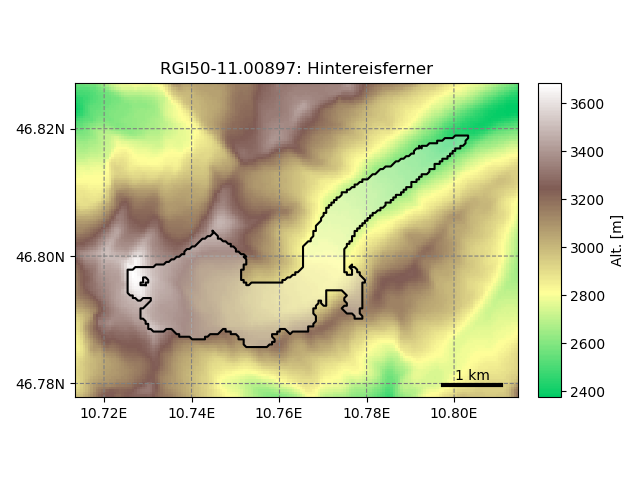Getting started¶
The ultimate goal of OGGM will be to hide the python workflow behind the model entirely, and run it only using configuration files and scripts. We are not there yet, and if you want to use and participate to the development of OGGM you’ll have to get your hands dirty. We hope however that the workflow is structured enough so that it is possible to jump in without having to understand all of its internals.
The few examples below are meant to illustrate the general design of OGGM, without going into the details of the implementation.
Imports¶
The following imports are necessary for all of the examples:
In [1]: import geopandas as gpd
In [2]: import oggm
In [3]: from oggm import cfg, tasks, graphics
In [4]: from oggm.utils import get_demo_file
Initialisation and GlacierDirectories¶
The first thing to do when running OGGM is to initialise it. This function will read the default configuration file which contains all user defined parameters:
In [5]: cfg.initialize()
These parameters are now accessible to all OGGM routines. For example, the
cfg.PARAMS dict contains some runtime parameters, while cfg.PATHS stores
the paths to the input files and the working directory (where the model output
will be written):
In [6]: cfg.PARAMS['topo_interp']
Out[6]: 'cubic'
In [7]: cfg.PARAMS['temp_default_gradient']
����������������Out[7]: -0.0065
In [8]: cfg.PATHS
��������������������������������Out[8]:
PathOrderedDict([('dl_cache_dir', '/home/docs/OGGM/download_cache'),
('tmp_dir', '/home/docs/OGGM/tmp'),
('cru_dir', '/home/docs/OGGM/cru'),
('rgi_dir', '/home/docs/OGGM/rgi'),
('test_dir', '/home/docs/OGGM/tests'),
('working_dir', ''),
('dem_file', ''),
('climate_file', '')])
We’ll use some demo files (shipped with OGGM) for the basic input:
In [9]: cfg.PATHS['working_dir'] = os.path.expanduser('~/doc_wd') # working directory
In [10]: cfg.PATHS['dem_file'] = get_demo_file('hef_srtm.tif') # topography
In [11]: cfg.set_intersects_db(get_demo_file('rgi_intersect_oetztal.shp')) # intersects
The starting point of a run is always a valid RGI file. In this case we use a very small subset of the RGI, the outlines of the Hinereisferner (HEF) in the Austrian Alps:
In [12]: entity = gpd.GeoDataFrame.from_file(get_demo_file('HEF_MajDivide.shp')).iloc[0]
In [13]: entity
Out[13]:
Area 6.24736
Aspect 71
BgnDate 20030799
CenLat 46.8003
CenLon 10.7584
EndDate 20030999
GLIMSId G010758E46800N
GlacType 0091
Lmax 7178
Name Hintereisferner
O1Region 11
O2Region 1
RGIFlag 0909
RGIId RGI50-11.00897
Slope 16
Zmax 3674
Zmed 3050
Zmin 2430
geometry POLYGON ((10.74505084001018 46.80376064580748,...
Name: 0, dtype: object
This information is enough to define HEF’s GlacierDirectory:
In [14]: gdir = oggm.GlacierDirectory(entity)
Glacier working directories have two major purposes:
- carry information about the glacier attributes
- handle I/O and filepaths operations
For example, it will tell OGGM where to write the data for this glacier or its terminus type:
In [15]: gdir.dir
Out[15]: '/home/docs/doc_wd/per_glacier/RGI50-11/RGI50-11.00/RGI50-11.00897'
In [16]: gdir.terminus_type
�����������������������������������������������������������������������������Out[16]: 'Land-terminating'
GlacierDirectories are the input to most OGGM functions. In fact, they are the
only required input to all Entity tasks. These entity tasks are
processes which can run on one glacier at a time (the vast majority of OGGM
tasks are entity tasks). The first task to apply to an empty GlacierDirectory
is tasks.define_glacier_region(), which sets the local glacier map
and topography, and tasks.glacier_masks(), which prepares gridded
topography data:
In [17]: tasks.define_glacier_region(gdir, entity=entity)
In [18]: tasks.glacier_masks(gdir)
In [19]: os.listdir(gdir.dir)
Out[19]:
['intersects.cpg',
'outlines.dbf',
'geometries.pkl',
'outlines.cpg',
'intersects.shx',
'dem_source.pkl',
'intersects.shp',
'gridded_data.nc',
'outlines.shx',
'intersects.prj',
'outlines.shp',
'log.txt',
'dem.tif',
'glacier_grid.json',
'intersects.dbf',
'outlines.prj']
The directory is now filled with data. Other tasks can build upon these, for example the plotting functions:
In [20]: graphics.plot_domain(gdir)

What next?¶
This documentation is growing step by step. In the meantime, a good place
to start is the oggm/docs/notebooks directory.
You will find two notebooks:
getting_started.ipynb, which set-ups an entire OGGM run in the Ötztal region.flowline_model.ipynb, which describes the usage of the flowline model for idealized test cases.